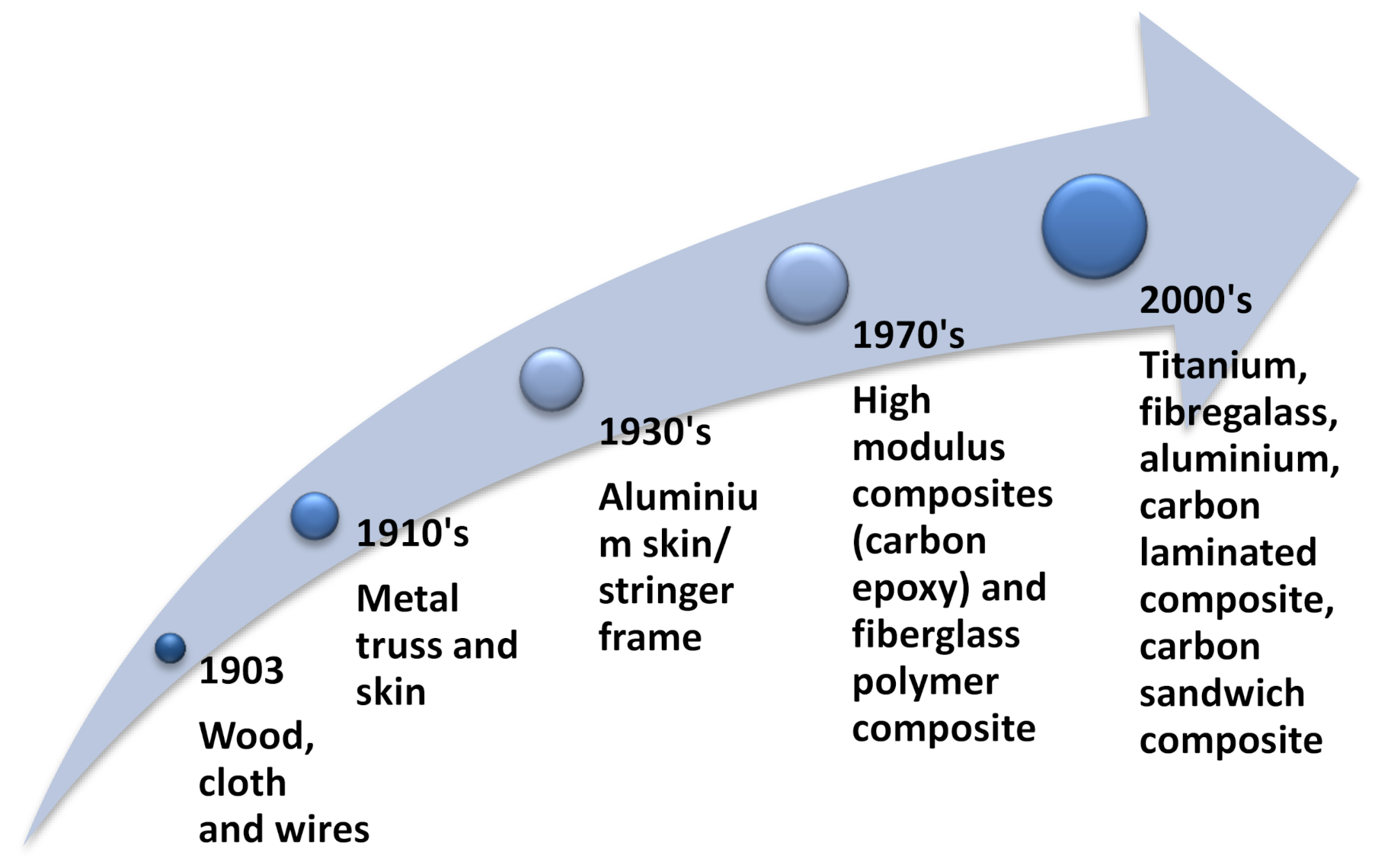Engineered Nanomaterials for Aviation Industry in COVID-19 Context: A Time-Sensitive Review
Abstract
1. Introduction
- Uttered by particle size, i.e., Griffith criteria, morphology, interfacial strength (e.g., chemistry and roughness).
- High surface area and aspect ratios, radically changing nanomaterial properties as opposed to bulk material properties.
- Possess perfection in molecularity, extremely ordered, and have defect-free structures.
- Particle size and interatomic voids can control the thermal conductivity.
- Particle size and surface properties can control and affect the emissivity.
- In terms of conductivity, bandgap energy, current density, and thermoelectric properties can be influenced by nanostructure and impurities.
- Threshold and field emission can be enhanced using high aspect ratios.
- Nanoscale dimensions can influence radiation resistance.
2. Classification of ENMs and Their Correlation with Aviation Industry
3. ENMs Properties and Applications
3.1. Air Frame Structure
3.1.1. Carbon Nanotubes (CNTs)-Based Polymer Composites
3.1.2. Nanoclays-Reinforced Polymer Composites
4. ENMs in Developing Aerospace-Focused Antiviral Films/Coatings
- The total reduction varies from 42% to 52% of the seats provided by airlines.
- A net drop of 2369 to 2947 million passengers.
- Approximately USD 316 to 390 billion possible loss of net operating profit of airlines.
5. ENMs Synthesis Techniques
- Control over NMs volume, size, form, crystalline structure, composition and distribution.
- Improved nanomaterial cleanliness.
- Stability in physical characteristics and structures.
- Higher replicability and aggregation control.
- Large scale production and lower cost.
6. Advantages and Limitations of ENMs in Aviation
- As discussed above in the paper that the ENMs include structural parts of polymers nano-composites; extreme powered rechargeable batteries, thermoelectrical materials for control of temperature; lower rolling tires; high efficacy and cost-effective sensors and electronics. In terms of improvement in high-performance, resilience and durability of aviation infrastructure ENMs made of aluminum, steel, copper, silicon and respective recycled formulations offer a great promise [7,8,9,10,11,12,91].
- Another common issue in aerospace vehicles is the surface deterioration of coatings because they are exposed to moisture, sunlight, and oxygen. By adding different ENMs, the surface degradation can be reduced while retaining the necessary properties of the layer. With several wall-mounted CNT, TiO2, SiO2 ENMs, and graphene, surface cracks decrease, UV degradation decreases and increases its lifespan. Inclusion of nanoclay to aircraft paints provides high fire retardant and also enables scratch-resistant properties [7,8,9,10,11,91].
- Aircraft engines are rendered excellent by including nanoclay and ZrO ENMs in the composite associated with Y2O3. The coating with nanofilms of engine parts facilitates self-cleaning and reduces friction. Comprehensive readings of different pressure and temperature are provided by Nanosensors and NEMS [7,91].
- For the protection of critical aircraft components from electromagnetics, nanomaterials like single-walled CNTs can be used.
- Although there are numerous advantages of nanocoatings compared to traditional coatings, some issues require further development. Main problems in nanocoatings are nanoparticles scattering and stability, pigments can lose color and ultra-fine particle hardness [91].
7. Conclusions and Perspective
Author Contributions
Funding
Institutional Review Board Statement
Informed Consent Statement
Data Availability Statement
Conflicts of Interest
References
- Sgouridis, S.; Bonnefoy, P.A.; Hansman, R.J. Air transportation in a carbon constrained world: Long-term dynamics of policies and strategies for mitigating the carbon footprint of commercial aviation. Transp. Res. Part A Policy Pract. 2011, 45, 1077–1091. [Google Scholar] [CrossRef]
- Mouritz, A.P. Aerospace materials: Past, present and future. In Introduction to Aerospace Materials; Woodhead Publishing: Cambridge, UK, 2012; pp. 15–38. [Google Scholar]
- Ghuge, S.V.; Fanisam, M.B.N. Composite Material and Nanomaterials on Stealth Technology. Int. J. Modern Trends Eng. Res. 2017, 4, 36–39. [Google Scholar]
- Kumar, I. Nanocraft—An Aircraft with Nanotechnology. Int. J. Res. Appl. Sci. Eng. Technol. (IJRASET) 2015, 3, 215–220. [Google Scholar]
- Wu, W.; Wu, Z.; Yu, T.; Jiang, C.; Kim, W.S. Recent progress on magnetic iron oxide nanoparticles: Synthesis, surface functional strategies and biomedical applications. Sci. Technol. Adv. Mater. 2015, 16, 023501. [Google Scholar] [CrossRef] [PubMed]
- Orhan, E.; Yuksel, M.; Ari, A.B.; Yanik, C.; Hatipoglu, U.; Yağci, A.M.; Hanay, M.S. Performance of Nano-Electromechanical Systems as Nanoparticle Position Sensors. Front. Mech. Eng. 2020, 6, 37. [Google Scholar] [CrossRef]
- Meyyappan, M. Nanotechnology in Aerospace Applications. In Nanotechnology Aerospace Applications; NATO Lectures: Fort Belvoir, VA, USA, 2006; pp. 7.1–7.2. [Google Scholar]
- Baur, J.; Silverman, E. Challenges and opportunities in multifunctional nanocomposite structures for aerospace applications. MRS Bull. 2007, 32, 328–334. [Google Scholar] [CrossRef]
- Wen, G.; Guo, Z.; Liu, W. Biomimetic polymeric superhydrophobic surfaces and nanostructures: From fabrication to applications. Nanoscale 2017, 9, 3338–3366. [Google Scholar] [CrossRef]
- Paul, D.; Kelly, L.; Venkayya, V.; Hess, T. Evolution of U.S. military aircraft structures technology. J. Aircr. 2002, 39, 18–29. [Google Scholar] [CrossRef]
- Megson, T.H.G. Aircraft Structures for Engineering Students; Butterworth-Heinemann: Oxford, UK, 2016. [Google Scholar]
- Peery, D.J. Aircraft Structures; Dover Publications: Mineola, NY, USA, 2011. [Google Scholar]
- Dursun, T.; Soutis, C. Recent developments in advanced aircraft aluminium alloys. Mater. Des. 2014, 56, 862–871. [Google Scholar] [CrossRef]
- O’Donnell, S.; Sprong, K.; Haltli, B. Potential impact of carbon nanotube reinforced polymer composite on commercial aircraft performance and economics. In Proceedings of the AIAA 4th Aviation Technology, Integration and Operations (ATIO) Forum, Virginia, VA, USA, 20 September 2004; p. 6402. [Google Scholar] [CrossRef][Green Version]
- Fiore, V.; Scalici, T.; Di Bella, G.; Valenza, A. A review on basalt fibre and its composites. Compos. Part B Eng. 2015, 74, 74–94. [Google Scholar] [CrossRef]
- Iijima, S. Helical microtubules of graphitic carbon. Nature 1991, 354, 56. [Google Scholar] [CrossRef]
- Xia, Z.; Riester, L.; Curtin, W.; Li, H.; Sheldon, B.; Liang, J.; Chang, B.; Xu, J. Direct observation of toughening mechanisms in carbon nanotube ceramic matrix composites. Acta Mater. 2004, 52, 931–944. [Google Scholar] [CrossRef]
- Flahaut, E.; Peigney, A.; Laurent, C.; Marliere, C.; Chastel, F.; Rousset, A. Carbon nanotube-metal-oxide nanocomposites: Microstructure, electrical conductivity and mechanical properties. Acta Mater. 2000, 48, 3803–3812. [Google Scholar] [CrossRef]
- Li, Q.; Viereckl, A.; Rottmair, C.A.; Singer, R.F. Improved processing of carbon nanotube/magnesium alloy composites. Compos. Sci. Technol. 2009, 69, 1193–1199. [Google Scholar] [CrossRef]
- Johnson, R.R.; Johnson, A.T.C.; Klein, M.L. Probing the Structure of DNA-Carbon Nanotube Hybrids with Molecular Dynamics. Nano Lett. 2008, 8, 69–75. [Google Scholar] [CrossRef] [PubMed]
- Peng, C.; Zhang, S.; Jewell, D.; Chen, G.Z. Carbon nanotube and conducting polymer composites for supercapacitors. Prog. Nat. Sci. 2008, 18, 777–788. [Google Scholar] [CrossRef]
- Thostenson, E.; Li, C.; Chou, T. Nanocomposites in context. Compos. Sci. Technol. 2005, 65, 491–516. [Google Scholar] [CrossRef]
- Saini, P.; Aror, M. Microwave Absorption and EMI Shielding Behavior of Nanocomposites Based on Intrinsically Conducting Polymers, Graphene and Carbon Nanotubes in New Polymers for Special Applications; De Souza Gomes, A., Ed.; InTech: Rijeka, Croatia, 2012. [Google Scholar]
- Meincke, O.; Kaempfer, D.; Weickmann, H.; Friedrich, C.; Vathauer, M.; Warth, H. Mechanical properties and electrical conductivity of carbon-nanotube filled polyamide-6 and its blends with acrylonitrile/butadiene/styrene. Polymer 2004, 45, 739–748. [Google Scholar] [CrossRef]
- Saini, P.; Choudhary, V.; Singh, B.P.; Mathur, R.B.; Dhawan, S.K. Enhanced microwave absorption behavior of polyaniline-CNT/polystyrene blend in 12.4–18.0 GHz range. Synth. Met. 2011, 161, 1522–1526. [Google Scholar] [CrossRef]
- Khan, W.; Sharma, R.; Saini, P. Carbon nanotube-based polymer composites: Synthesis, properties and applications. In Carbon Nanotubes-Current Progress of their Polymer Composites; InTech: Rijeka, Croatia, 2016. [Google Scholar]
- Lian, W.; Liu, S.; Yu, J.; Li, J.; Cui, M.; Xu, W.; Huang, J. Electrochemical sensor using neomycin-imprinted film as recognition element based on chitosan-silver nanoparticles/graphene-multiwalled carbon nanotubes composites modified electrode. Biosens. Bioelectron. 2013, 44, 70–76. [Google Scholar] [CrossRef]
- Noor, N.A.M.; Razak, J.A.; Ismail, S.; Mohamad, N.; Tee, L.K.; Munawar, R.F.; Junid, R. Review on Carbon Nanotube based Polymer Composites and Its Applications. J. Adv. Manuf. Technol. 2018, 12, 311–326. [Google Scholar]
- Gholivand, M.B.; Mohammadi-Behzad, L. An electrochemical sensor for warfarin determination based on covalent immobilization of quantum dots onto carboxylated multiwalled carbon nanotubes and chitosan composite film modified electrode. Mater. Sci. Eng. C 2015, 57, 77–87. [Google Scholar] [CrossRef]
- Rajalakshmi, K.; John, S.A. Functionalized multiwalled carbon nanotubes-nanostructured conducting polymer composite modified electrode for the sensitive determination of uricase inhibitor. Electrochim. Acta 2015, 173, 506–514. [Google Scholar] [CrossRef]
- Costa, P.M.F.J.; Silvia, C.; Viana, J.C.; Mendez, S.L. Extruded thermoplastic elastomers styrene–butadiene–styrene/carbon nanotubes composites for strain sensor applications. Compos. Part B Eng. 2014, 57, 242–249. [Google Scholar] [CrossRef]
- Ma, P.-C.; Siddiqui, N.A.; Marom, G.; Kim, J.-K. Dispersion and functionalization of carbon nanotubes for polymer-based nanocomposites: A review. Compos. Part A Appl. Sci. Manuf. 2010, 41, 1345–1367. [Google Scholar]
- Moon, S.; Vuong, N.M.; Lee, D.; Kim, D.; Lee, H.; Kim, D.; Hong, S.-K.; Yoon, S.-G. Co3O4–SWCNT composites for H2S gas sensor application. Sens. Actuators B Chem. 2016, 222, 166–172. [Google Scholar] [CrossRef]
- Benedetti, J.E.; Corrêa, A.A.; Carmello, M.; Almeida, L.C.; Gonçalves, A.S.; Nogueira, A.F. Cross-linked gel polymer electrolyte containing multi-wall carbon nanotubes for application in dye-sensitized solar cells. J. Power Sources 2012, 208, 263–270. [Google Scholar] [CrossRef]
- Gendron, D.; Ansaldo, A.; Bubak, G.; Ceseracciu, L.; Vamvounis, G.; Ricci, D. Poly(ionic liquid)-carbon nanotubes self-supported, highly electroconductive composites and their application in electroactive devices. Compos. Sci. Technol. 2015, 117, 364–370. [Google Scholar] [CrossRef]
- Chen, H.; Zeng, S.; Chen, M.; Zhang, Y.; Li, Q. Fabrication and functionalization of carbon nanotube films for high-performance flexible supercapacitors. Carbon 2015, 92, 271–296. [Google Scholar] [CrossRef]
- Feng, L.; Wang, C.; Song, P.; Wang, H.; Zhang, X. The form-stable phase change materials based on polyethylene glycol and functionalized carbon nanotubes for heat storage. Appl. Therm. Eng. 2015, 90, 952–956. [Google Scholar]
- Jeong, H.T.; Kim, B.C.; Higgins, M.J.; Wallace, G.G. Highly stretchable reduced graphene oxide (rGO)/single-walled carbon nanotubes (SWNTs) electrodes for energy storage devices. Electrochim. Acta 2015, 163, 149–160. [Google Scholar] [CrossRef]
- Serrano, M.C.; Gutiérrez, M.C.; Del Monte, F. Role of polymers in the design of 3D carbon nanotube-based scaffolds for biomedical applications. Prog. Polym. Sci. 2014, 39, 1448–1471. [Google Scholar] [CrossRef]
- Przekora, A.; Benko, A.; Nocun, M.; Wyrwa, J.; Blazewicz, M.; Ginalska, G. Titanium coated with functionalized carbon nanotubes—A promising novel material for biomedical application as an implantable orthopaedic electronic device. Mater. Sci. Eng. C 2014, 45, 287–296. [Google Scholar] [CrossRef]
- Nie, C.; Ma, L.; Xia, Y.; He, C.; Deng, J.; Wang, L.; Cheng, C.; Sun, S.; Zhao, C. Novel heparin-mimicking polymer brush grafted carbon nanotube/PES composite membranes for safe and efficient blood purification. J. Membr. Sci. 2015, 475, 455–468. [Google Scholar]
- Vakarelski, I.U.; Brown, S.C.; Higashitani, K.; Moudgil, B.M. Penetration of Living Cell Membranes with Fortified Carbon Nanotube Tips. Langmuir 2007, 23, 10893–10896. [Google Scholar] [CrossRef] [PubMed]
- Ebron, V.H.; Yang, Z.; Seyer, D.J.; Kozlov, M.E.; Oh, J.; Xie, H.; Razal, J.; Hall, L.J.; Ferraris, J.P.; MacDiarmid, A.G.; et al. Fuel-Powered Artificial Muscles. Science 2006, 311, 1580–1583. [Google Scholar]
- Dunne, N.; Mitchell, C. Biomedical/bioengineering applications of carbon nanotube-based nanocomposites. In Polymer-Carbon Nanotube Composite; McNally, T., Pötschke, P., Eds.; Woodhead Publishing: Cambridge, UK, 2011; pp. 676–717. [Google Scholar]
- Kim, Y.; Lee, S.; Choi, H.H.; Noh, J.-S.; Lee, W. Detection of a nerve agent simulant using single-walled carbon nanotube networks: Dimethyl-methyl-phosphonate. Nanotechnology 2010, 21, 495501. [Google Scholar] [CrossRef] [PubMed][Green Version]
- Karippal, J.J.; Narasimha Murthy, H.N.; Rai, K.S.; Sreejith, M.; Krishna, M. Study of mechanical properties of epoxy/glass/nanoclay hybrid composites. J. Compos. Mater. 2011, 45, 1893–1899. [Google Scholar] [CrossRef]
- Schmidt, D.; Shah, D.; Giannelis, E.P. New advances in polymer/layered silicate nanocomposites. Curr. Opin. Solid State Mater. Sci. 2002, 6, 205–212. [Google Scholar] [CrossRef]
- Ray, S.S.; Okamoto, M. Polymer/layered silicate nanocomposites: A review from preparation to processing. Prog. Polym. Sci. 2003, 28, 1539–1641. [Google Scholar]
- Gacitua, W.; Ballerini, A.; Zhang, J. Polymer nanocomposites: Synthetic and natural fillers a review. Maderas. Cienc. Y Tecnol. 2005, 7, 159–178. [Google Scholar] [CrossRef]
- Guo, F.; Aryana, S.; Han, Y.; Jiao, Y. A Review of the Synthesis and Applications of Polymer–Nanoclay Composites. Appl. Sci. 2018, 8, 1696. [Google Scholar] [CrossRef]
- Vo, V.S.; Mahouche-Chergui, S.; Nguyen, V.H.; Naili, S.; Singha, N.K.; Carbonnier, B. Chemical and Photochemical Routes Toward Tailor-Made Polymer–Clay Nanocomposites: Recent Progress and Future Prospects. In Clay-Polymer Nanocomposites; Elsevier: Amsterdam, The Netherlands, 2017; pp. 145–197. [Google Scholar] [CrossRef]
- Asmatulu, R. Nanocoatings for corrosion protection of aerospace alloys. In Corrosion Protection and Control. Using Nanomaterials; Elsevier: Amsterdam, The Netherlands, 2012; pp. 357–374. [Google Scholar] [CrossRef]
- Global Industry Analysts, Inc. Expanding role in the field of surface protection supported by continuous technology innovations to spur opportunities for the growth of nanocoatings. In Nanocoating-Market Analysis, Trends, and Forecasts; Global Industry Analysts, Inc.: San Jose, CA, USA, 2018; p. 202. [Google Scholar]
- AZoNano. Nanotechnology Coatings in the Defence and Aerospace Industry. 2004. Available online: https://www.azonano.com/article.aspx?ArticleID=568 (accessed on 18 November 2020).
- Roberge, P.R. Corrosion Engineering, Principals and Practice; McGraw-Hill: New York, NY, USA, 2008. [Google Scholar]
- Cui, C.Y.; Cui, X.G.; Zhao, Q.; Ren, X.D.; Zhou, J.Z.; Liu, Z.; Wang, Y.M. Simulation, microstructure and microhardness of the nano-SiC coating formed on Al surface via laser shock processing. Mater. Des. 2014, 62, 217–224. [Google Scholar] [CrossRef]
- Mohamed Musthafa, M.; Sivapirakasam, S.P.; Udayakumar, M. Comparative studies on fly ash coated low heat rejection diesel engine on performance and emission characteristics fueled by rice bran and pongamia methyl ester and their blend with diesel. Energy 2011, 36, 2343–2351. [Google Scholar] [CrossRef]
- Cavaleiro, A.; de Hosson, J.T.M. Nanostructured Coatings; Springer: Berlin/Heidelberg, Germany, 2006. [Google Scholar]
- Bayer, I.S.; Krishnan, K.G.; Robison, R.; Loth, E.; Berry, D.H.; Farrell, T.E.; Crouch, J.D. Thermal alternating polymer nanocomposite (TAPNC) coating designed to prevent aerodynamic insect fouling. Sci. Rep. 2016, 6, 38459. [Google Scholar] [CrossRef]
- Basiru, Y.A.; Ammar, S.; Ramesh, K.; Vengadaesvaran, B.; Ramesh, S.; Arof, A.K. Corrosion protection performance of nanocomposite coatings under static, U.V. and dynamic conditions. J. Coat. Technol. Res. 2018, 15, 1035–1047. [Google Scholar] [CrossRef]
- Fan, X.; Xue, Q.; Wang, L. Carbon-based solid-liquid lubricating coatings for space applications—A review. Friction 2015, 3, 191–207. [Google Scholar] [CrossRef]
- Redondo, O.; Prolongo, S.G.; Campo, M.; Sbarufatti, C.; Giglio, M. Anti-icing and de-icing coatings based Joule’s heating of graphene nanoplatelets. Compos. Sci. Technol. 2018, 164, 65–73. [Google Scholar] [CrossRef]
- Karim, N.; Zhang, M.; Afroj, S.; Koncherry, V.; Potluri, P.; Novoselov, K.S. Graphene-based surface heater for de-icing applications. RSC Adv. 2018, 8, 16815–16823. [Google Scholar] [CrossRef]
- Zhao, Z.; Chen, H.; Liu, X.; Liu, H.; Zhang, D. Development of high-efficient synthetic electric heating coating for anti-icing/de-icing. Surf. Coat. Technol. 2018, 349, 340–346. [Google Scholar] [CrossRef]
- Khadak, A.; Uddin, M.N.; Rahman, M.M.; Asmatulu, R. Enhancing the De-Icing Capabilities of Carbon Fiber-Reinforced Composite Aircraft via Permanent Superhydrophobic Coatings. In Proceedings of the Composites and Advanced Materials ExpoAt, Dallas, TX, USA, 18–21 October 2018. [Google Scholar]
- Sun, T.; Fan, H.; Wang, Z.; Liu, X.; Wu, Z. Modified nano Fe2O3-epoxy composite with enhanced mechanical properties. Mater. Des. 2015, 87, 10–16. [Google Scholar] [CrossRef]
- Civcisa, G.; Leemet, T. 3D Surface Roughness Parameters of Nanostructured Coatings with Application in the Aerospace Industry. In Applied Mechanics and Materials; Trans Tech Publications: Stafa-Zurich, Switzerland, 2015; Volume 772, pp. 3–7. [Google Scholar]
- Roy, S.; Reddy, S.R.; Sindhuja, P.; Das, D.; Bhauprasad, V.V. AlPO4-C Composite Coating on Ni-based Super Alloy Substrates for High Emissivity Applications: Experimentation on Dip Coating and Spray Coating. Def. Sci. J. 2016, 66, 425–433. [Google Scholar] [CrossRef][Green Version]
- Huan, H.; Mandelis, A.; Liu, L.; Melnikov, A. Evaluation of mechanical performance of NiCo nanocoated aerospace aluminum alloy using quantitative photo-thermo-mechanical radiometry as a non-contact strain gauge. NDT E Int. 2017, 87, 44–49. [Google Scholar] [CrossRef]
- Delfini, A.; Vricella, A.; Morles, R.B.; Pastore, R.; Micheli, D.; Gugliermetti, F.; Marchetti, M. CVD nanocoating of carbon composites for space materials atomic oxygen shielding. Procedia Struct. Integr. 2017, 3, 208–216. [Google Scholar] [CrossRef]
- Ng, Y.H.; Tay, S.W.; Hong, L. Formation of Icephobic Surface with Micron-Scaled Hydrophobic Heterogeneity on Polyurethane Aerospace Coating. ACS Appl. Mater. Interfaces 2018, 10, 37517–37528. [Google Scholar] [CrossRef] [PubMed]
- Gul, S.; Kausar, A.; Muhammad, B.; Jabeen, S.; Farooq, M.; Kashif, M. Synthesis and Characterization of Novel Nanobifiller filled Epoxy Anti-Corrosive Nano-Organic coating for High Performance Automotive Applications. Am. J. Polym. Sci. Eng. 2018, 6, 1–23. [Google Scholar]
- Fazli-Shokouhi, S.; Nasirpouri, F.; Khatamian, M. Polyaniline-modified graphene oxide nanocomposites in epoxy coatings for enhancing the anticorrosion and antifouling properties. J. Coat. Technol. Res. 2019, 16, 983–997. [Google Scholar] [CrossRef]
- Iribarren, A.; Rivero, P.J.; Berlanga, C.; Larumbe, S.; Miguel, A.; Palacio, J.F.; Rodriguez, R. Multifunctional Protective PVC-ZnO Nanocomposite Coatings Deposited on Aluminum Alloys by Electrospinning. Coatings 2019, 9, 216. [Google Scholar] [CrossRef]
- McPherson, R. The relationship between the mechanism of formation, microstructure and properties of plasma-sprayed coating. Thin Solid Film 1981, 83, 297–310. [Google Scholar] [CrossRef]
- Shaw, L.; Goberman, L.D.; Ren, R.; Gell, M.; Jiang, S.; Wang, Y.; Xiao, T.D.; Strutt, P.R. The dependency of microstructure and properties of nanostructured coatings on plasma spray conditions. Surface Coat. Technol. 2000, 130, 1–8. [Google Scholar] [CrossRef]
- Scientists Develop Anti-Coronavirus Surface Coating Based on Nanomaterials-COVID-19. Available online: https://www.hospimedica.com/covid-19/articles/294782200/scientists-develop-anti-coronavirus-surface-coating-based-on-nanomaterials.html (accessed on 25 November 2020).
- Effects of Novel Coronavirus (COVID-19) on Civil Aviation: Economic Impact Analysis; International Civil Aviation Organization (ICAO): Canada, 9 July 2020. Available online: https://www.icao.int/sustainability/Documents/COVID-19/ICAO_Coronavirus_Econ_Impact.pdf (accessed on 25 November 2020).
- van Doremalen, N.; Bushmaker, T.; Morris, D.H.; Holbrook, M.G.; Gamble, A.; Williamson, B.N.; Tamin, A.; Harcourt, J.L.; Thornburg, N.J.; Gerber, S.I.; et al. Aerosol and surface stability of HCoV-19 (SARS-CoV-2) compared to (SARS-CoV-1). N. Engl. J. Med. 2020, 382, 1564–1567. [Google Scholar] [CrossRef] [PubMed]
- Rai, P.K.; Usmani, Z.; Thakur, V.K.; Gupta, V.K.; Mishra, Y.K. Tackling COVID-19 Pandemic through Nanocoatings: Confront and Exactitude. Curr. Res. Green Sustain. Chem. 2020, 3, 100011. [Google Scholar] [CrossRef]
- Hodek, J.; Zajícová, V.; Lovětinská-Šlamborová, I.; Stibor, I.; Müllerová, J.; Weber, J. Protective hybrid coating containing silver, copper and zinc cations effective against human immunodeficiency virus and other enveloped viruses. BMC Microbiol. 2016, 16, 1–12. [Google Scholar] [CrossRef] [PubMed]
- Trigilio, J.; Antoine, T.E.; Paulowicz, I.; Mishra, Y.K.; Adelung, R.; Shukla, D. Tin Oxide Nanowires Suppress Herpes Simplex Virus-1 Entry and Cell-to-Cell Membrane Fusion. PLoS ONE 2012, 7, e48147. [Google Scholar] [CrossRef]
- Speshock, J.L.; Murdock, R.C.; Braydich-Stolle, L.K.; Schrand, A.M.; Hussain, S.M. Interaction of silver nanoparticles with Tacaribe virus. J. Nanobiotechnol. 2010, 8, 19–27. [Google Scholar] [CrossRef]
- Lu, L.; Sun, R.W.-Y.; Chen, R.; Hui, C.-K.; Ho, C.-M.; Luk, J.M.; Lau, G.K.K.; Che, C.-M. Silver nanoparticles inhibit hepatitis B virus replication. Antivir. Ther. 2008, 13, 253–262. [Google Scholar]
- Sun, L.; Singh, A.K.; Vig, K.; Pillai, S.R.; Singh, S.R. Silver nanoparticles inhibit replication of respiratory sincitial virus. J. Biomed. Biotechnol. 2008, 4, 149–158. [Google Scholar]
- Antoine, T.E.; Hadigal, S.R.; Yakoub, A.M.; Mishra, Y.K.; Bhattacharya, P.; Haddad, C.; Valyi-Nagy, T.; Adelung, R.; Prabhakar, B.S.; Shukla, D. Intravaginal zinc oxide tetrapod nanoparticles as novel immune protective agents against genital herpes. J. Immunol. 2016, 196, 4566–4575. [Google Scholar] [CrossRef]
- Development of Anti-Microbial Coating against COVID-19. 2020. Available online: https://www.asiabiotech.com/24/2404/24040056x.html#gsc.tab=0 (accessed on 26 November 2020).
- Jain, N.K.; Pathak, S.; Alam, M. Synthesis of Copper Nanoparticles by Pulsed Electrochemical Dissolution Process. Ind. Eng. Chem. Res. 2019, 58, 602–608. [Google Scholar] [CrossRef]
- Khilji, I.A.; Pathak, S.; Saffe, S.N.B.M.; Biswas, S.; Singh, Y. Opportunities and Challenges in Nanoparticles Formation by Electrical Discharge Machining; Pandey, K., Misra, R., Patowari, P., Dixit, U., Eds.; Recent Advances in Mechanical Engineering; Lecture Notes in Mechanical Engineering; Springer: Singapore, 2021. [Google Scholar] [CrossRef]
- Rao, B.G.; Mukherjee, D.; Reddy, B.M. Novel approaches for preparation of nanoparticles. In Nanostructures for Novel Therapy: Synthesis, Characterization and Applications; Ficai, D., Grumezescu, A., Eds.; Elsevier: Amsterdam, The Netherlands, 2017; pp. 1–36. [Google Scholar]
- Mathew, J.; Joya, J.; George, S.C. Potential applications of nanotechnology in transportation: A review. J. King Saud Univ. Sci. 2019, 31, 586–594. [Google Scholar] [CrossRef]
- Du, T.; Liang, J.; Dong, N.; Lu, J.; Fu, Y.; Fang, L.; Xiao, S.; Han, H. Glutathione-Capped Ag2S Nanoclusters Inhibit Coronavirus Proliferation through Blockage of Viral RNA Synthesis and Budding. ACS Appl. Mater. Interfaces 2018, 10, 4369–4378. [Google Scholar] [CrossRef] [PubMed]
- Imani, S.M.; Ladouceur, L.; Marshall, T.; Maclachlan, R.; Soleymani, L.; Didar, T.F. Antimicrobial Nanomaterials and Coatings: Current Mechanisms and Future Perspectives to Control the Spread of Viruses Including SARS-CoV-2. ACS Nano 2020, 14, 12341–12369. [Google Scholar] [CrossRef] [PubMed]
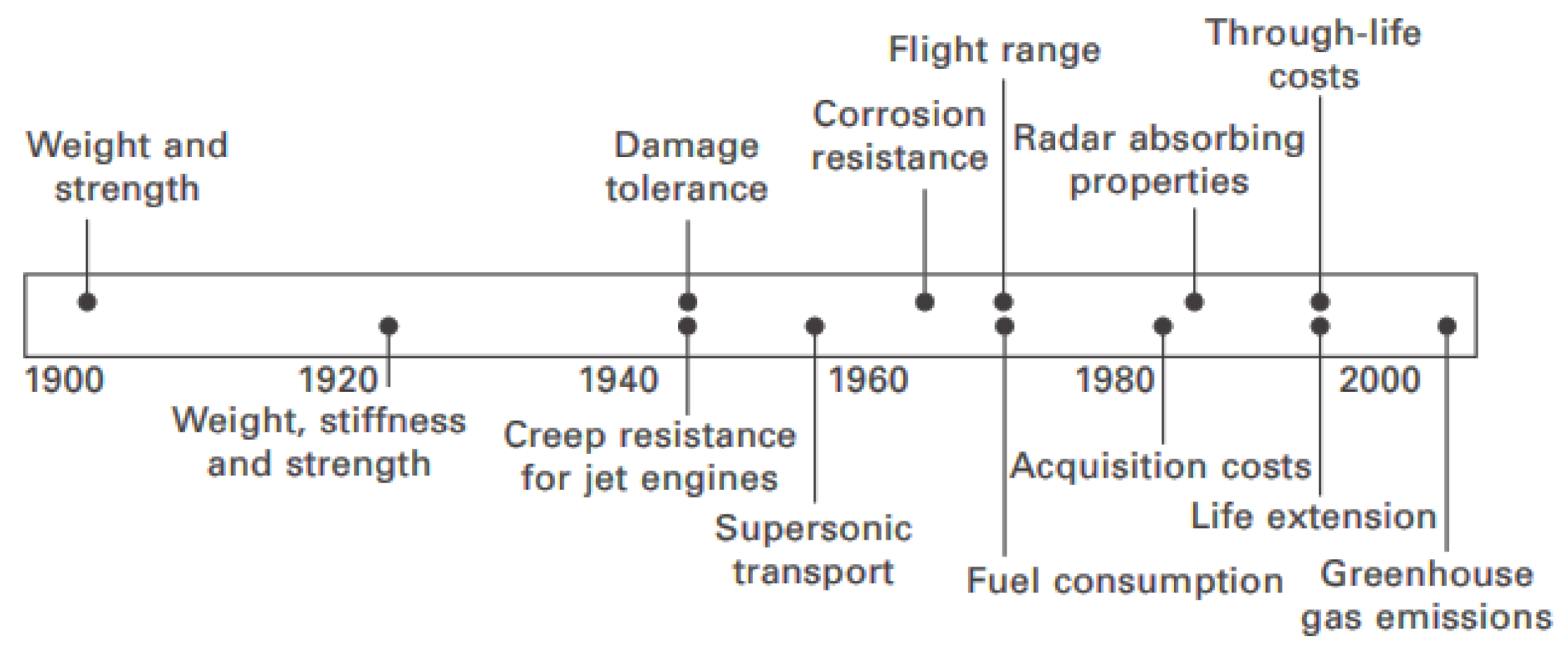
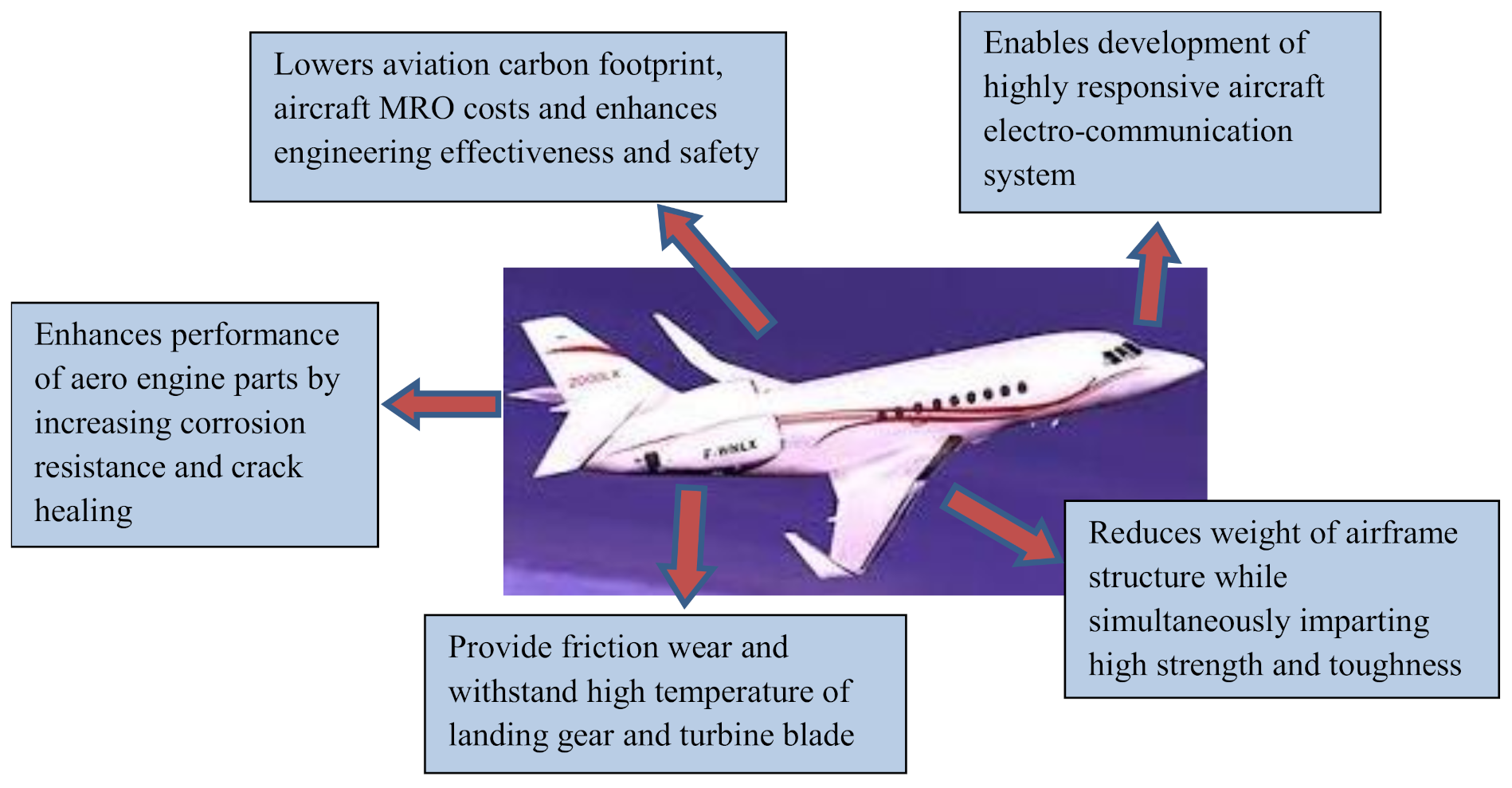
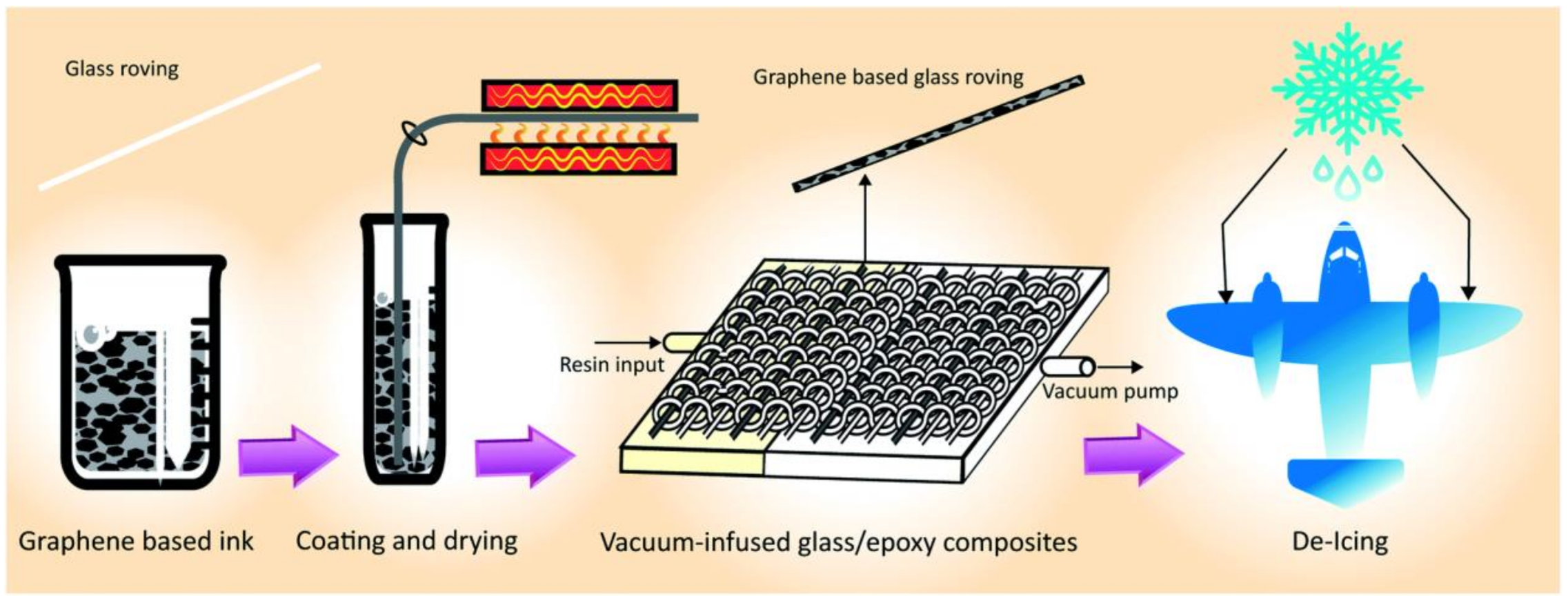
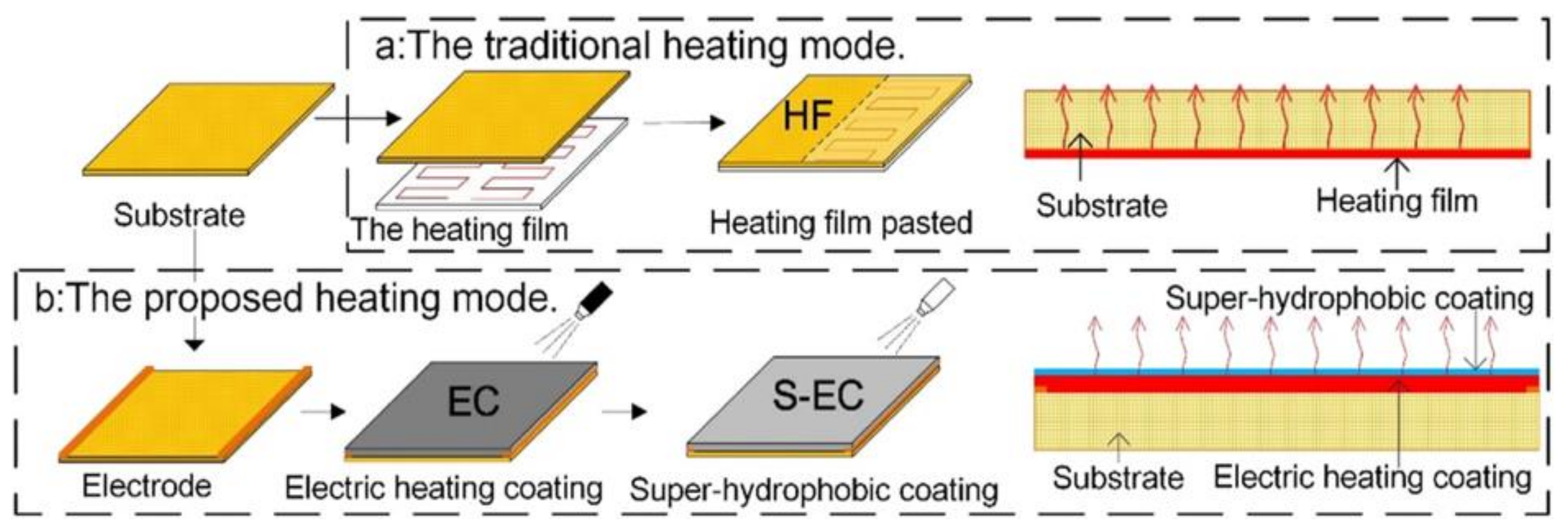
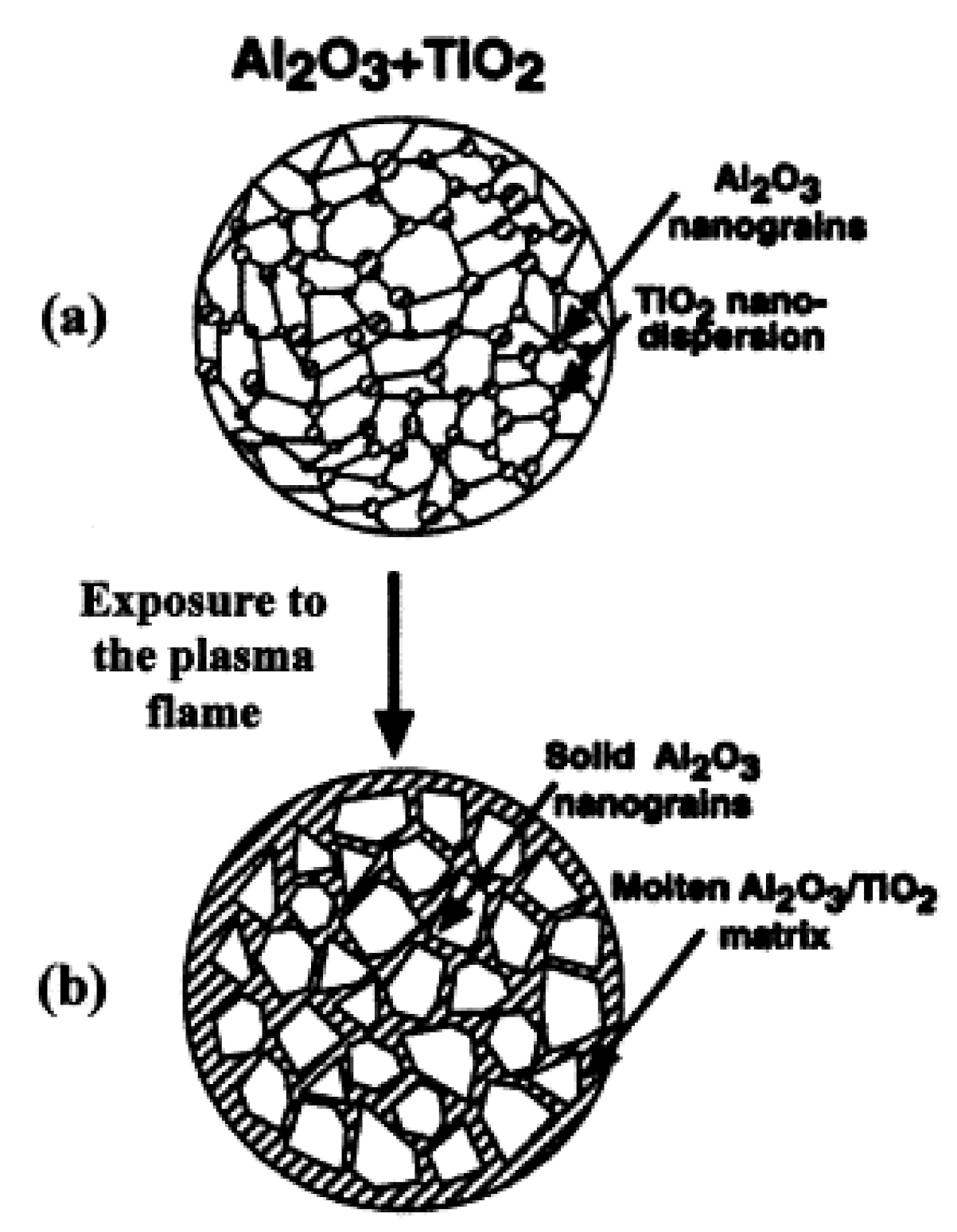
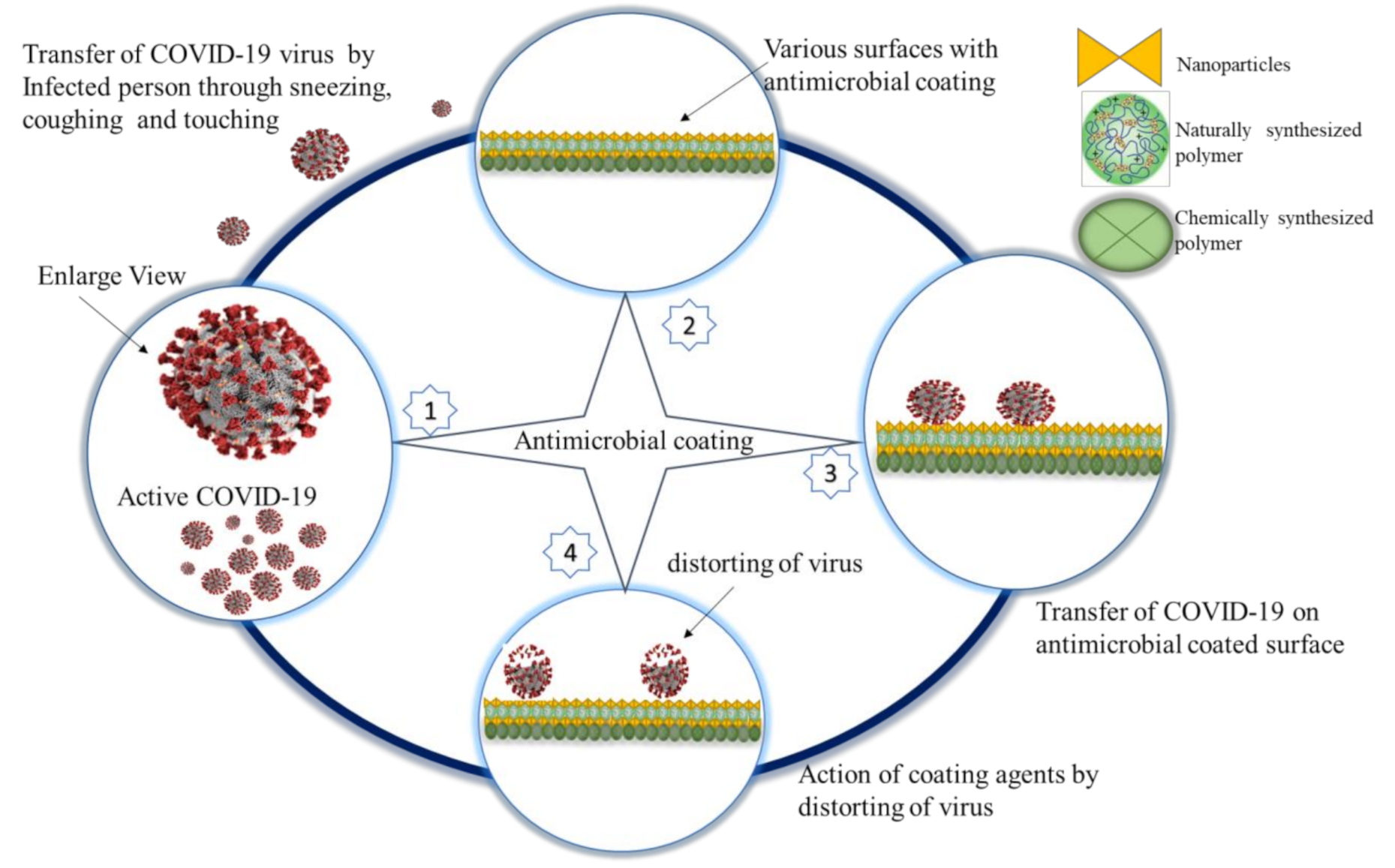

| Component Parts | Nanomaterials Used | Mechanical Properties |
|---|---|---|
| Airframe structure | 1. Carbon nanotube (CNT)-based polymer composites | Young’s modulus, high specific strength, crash resistance, and thermal performance. |
| 2. Nanoclay reinforced polymer composites | Barrier properties, thermal and flame retardant properties. | |
| 3. Metal nanoparticle incorporated composites | Extraordinary electrostatic discharge and electromagnetic interference (EMI) shielding properties which are resistant to lightning strikes. | |
| Aero-engine parts/components (nanocoatings) | 1. SiC nanoparticles in SiC-particle-reinforced alumina | Crack healing, improved high-temperature, high strength, and high creep resistance. |
| 2. TiN nanocrystallites embedded in amorphous Si3N4 | Wear-resistant coatings. | |
| 3. Nanocomposite coatings (crystalline carbide, diamond-like carbide (DLC) and metal dichalcogenide) | Low friction and wear-resistant applications of aircraft. | |
| 4. Nanotube and nanoparticles (nano graphite, nano aluminum) | Electrostatic discharge, EMI shielding and low friction applications of aircraft surfaces. | |
| Aircraft electro-communication systems | 1. Magnetic nanoparticles (iron oxide nanoparticles, i.e., Fe2O3 and Fe3O4) | High magnetic saturation, stability, biocompatibility, and interactive functions at the surface (used as data storage media). |
| 2. Ceramic nanoparticles (like barium strontium titanate, barium titanate) | Excellent dielectric properties (e.g., supercapacitor). | |
| 3. MEMS (Micro-electro-mechanical system) and NEMS (nano-electromechanical system) | Controls fuel in aero-engines. |
| Applications | Research Done |
|---|---|
| Sensor | - EC DNA sensor [29] |
| - EC warfarin sensor [30] | |
| - EC routine sensor [31] | |
| - Vapor of chemical gas sensor [32] | |
| - Strain sensor [33] | |
| - Gas sensor [34] | |
| Biomedical | - Scaffold in tissue engineering [35] |
| - Orthopedic implantable device [36] | |
| - Blood purification [37] | |
| - Nano-surgical needles [38] | |
| - Fuel empowered artificial muscles [39] | |
| - Joint replacement [40] | |
| Electronic devices | - Dye sensitized solar cells [41] |
| - Dry EC actuators [42] | |
| Energy storage | - Battery electrode [43] |
| - PCM thermal energy storage [44] | |
| - rGO/SWCNTs electrode [45] |
| Researchers | Year | Findings |
|---|---|---|
| Sun et al. [66] | 2015 | - Used cubic Fe2O3 NPs as nanofiller for epoxy matrix coating. - The interaction between Fe2O3 NPs and the epoxy matrix has improved the mechanical property by 1.5 times the tensile strength and two times better for fracture toughness. |
| Civcisa & Leemet [67] | 2015 | - Comparison of 3D surface roughness parameters between Ti-N coating and Ti-Al-N coating for the use of airplane blades. - Ti-Al-N coating gives smoother surface roughness compared to Ti-N coating. |
| Roy et al. [68] | 2016 | - Developed new AlPO4-C composite coating for Ni-based superalloy substrates using dip coating and spray coating techniques. - Improved the coating’s emissivity, which can prevent the oxidation on the base substrates at elevated temperature. |
| Huan et al. [69] | 2017 | - Tested the NiCo nanocoatings on aerospace aluminum alloy using non-contact photo-thermo-mechanical radiometry (PTMR). - NiCo coating can improve the mechanical properties of a coated material by strengthening the parts and protecting the defective substrate. |
| Delfini et al. [70] | 2017 | - They studied the effects of erosion by atomic oxygen onto carbon nanostructure as base material and carbon fiber as a coating material. - The disordered carbon deposit has seen an exacerbation, and improvement was accomplished by the high return carbon monofilaments deposition. |
| Ng et. al. [71] | 2018 | - A co-polymer coating and wax formulation generated hydrophobic and heterogeneous surface onto the aerospace P.U. topcoat. - The ice adhesion strength can reduce up to 47% and save up to 70% in energy required to remove the ice from the coating surface. |
| Gul et al. [72] | 2018 | - Observed that epoxy nanocomposites give a better corrosion resistance compared to pristine epoxy samples. |
| Fazli-Shokouhi et al. [73] | 2019 | - For anticorrosion, epoxy-12 wt. % PANI-GON coating revealed the highest anticorrosion level - For antifouling, epoxy-6 and 12 wt. % PANI-GON coatings show the most efficient antifouling level. |
| Iribarren et al. [74] | 2019 | - They analyzed the effect of different electrospinning deposition parameters on coating properties. - Electrospinning technique can enhance the surface resistance against localized corrosion by using the PVC-ZnO nanocomposite coating. |
| Authors and Year | Virus Designated by WHO | Antimicrobial Nanomaterials and Coatings | Application |
|---|---|---|---|
| Porgador et al. [77] | Covid-19 | Nanomaterials of antiviral and antibacterial metal ions (copper) and polymers | Avoid contamination and prevent virus entry |
| Lun et al. [87] | Covid-19 | Multilevel antimicrobial polymer | Avoid contamination and prevent virus entry up to 90 days on various surfaces of different materials. |
| Hodek et al. [81] | Spanish Flu (Influenza) | Coatings prepared by combinations of silver, copper, and zinc nanomaterials | Inhibit viral attachment to host plasma membrane |
| Trigilio et al. [82] | Herpes simplex virus type 1 (HSV-1) | Coatings prepared by tin oxide nanowires | Preventing virus entry into host cells |
| Speshock et al. [83] | Tacaribe virus (TCRV) | Polysaccharide-coated silver nanoparticles | It inactivates the infective virus before reaching the host cell |
| Lu et al. [84] | Hepatitis B virus (HBV) | Silver nanomaterials | Interfere with viral DNA replication and binding |
| Sun et al. [85] | Respiratory syncytial virus Herpes simplex virus type 2 (SV-2) | PVP-coated silver nanoparticles zinc oxide tetrapod nanoparticles (ZOTEN) | Viral binding to host cell interferes. Join with virions, and avoid cell entry |
| Type of Processes | Cost | Time | Oxidation | Waste Material |
|---|---|---|---|---|
| Chemical | High | High | High | High |
| Mechanical | High | High | Low | High |
| Physical | High | High | Low | Low |
| Physical Processes | Chemical Processes | Mechanical Processes |
|---|---|---|
| Physical vapor deposition, laser ablation, sputter deposition, electric arc deposition, ion implantation etc. | Sol-Gel, electrodeposition, colloidal methods, water-oil micro emulsions method, hydrothermal synthesis etc. | Attrition ball mill; vibrating ball mill; high energy ball mill; vibrator etc. |
| Advantages: Fewer losses compare with other processes, chemical-free process, | Advantages: Easy, less time consuming, large quantities of material can be obtaining, variety of size and shape, self-assembly or patterning possible | Advantages: Pure NM chemical-free process |
| Limitations: Time-consuming, required high-class setup, control over the process is a typical task, and high skilled labor is required. | Limitations: High cost, high chemical waste contaminated NMs, hazardous for environment and human. | Limitations: More space required; high energy required; the non-uniform shape of particles; phase change possibilities. |
Publisher’s Note: MDPI stays neutral with regard to jurisdictional claims in published maps and institutional affiliations. |
© 2021 by the authors. Licensee MDPI, Basel, Switzerland. This article is an open access article distributed under the terms and conditions of the Creative Commons Attribution (CC BY) license (http://creativecommons.org/licenses/by/4.0/).
Share and Cite
Pathak, S.; Saha, G.C.; Abdul Hadi, M.B.; Jain, N.K. Engineered Nanomaterials for Aviation Industry in COVID-19 Context: A Time-Sensitive Review. Coatings 2021, 11, 382. https://doi.org/10.3390/coatings11040382
Pathak S, Saha GC, Abdul Hadi MB, Jain NK. Engineered Nanomaterials for Aviation Industry in COVID-19 Context: A Time-Sensitive Review. Coatings. 2021; 11(4):382. https://doi.org/10.3390/coatings11040382
Chicago/Turabian StylePathak, Sunil, Gobinda C. Saha, Musfirah Binti Abdul Hadi, and Neelesh K. Jain. 2021. "Engineered Nanomaterials for Aviation Industry in COVID-19 Context: A Time-Sensitive Review" Coatings 11, no. 4: 382. https://doi.org/10.3390/coatings11040382
APA StylePathak, S., Saha, G. C., Abdul Hadi, M. B., & Jain, N. K. (2021). Engineered Nanomaterials for Aviation Industry in COVID-19 Context: A Time-Sensitive Review. Coatings, 11(4), 382. https://doi.org/10.3390/coatings11040382








